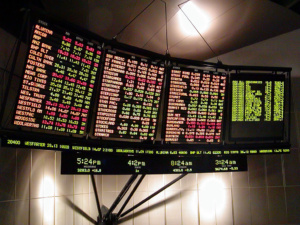Senior industry figure speaks about new SEC tick-size rulings
Nitin Gambhir, CEO of Tethys Technology On May 6, 2016, the SEC approved a two-year pilot program to widen the price quote tick size and certain other trading rules for a group of small-cap U.S. listed equities. The objective is to evaluate if the proposed change improve liquidity through increased market-making and also better price […]

Nitin Gambhir, CEO of Tethys Technology
On May 6, 2016, the SEC approved a two-year pilot program to widen the price quote tick size and certain other trading rules for a group of small-cap U.S. listed equities. The objective is to evaluate if the proposed change improve liquidity through increased market-making and also better price discovery. This, if achieved, should help with capital formation in the United States. The pilot also includes certain rule changes, especially in the third-test group (see below), that should provide data for further microstructure reforms.
The tick-size pilot will begin by October 3, 2016. It will include stocks of companies with $3 billion or less in market capitalization, an average daily trading volume of one million shares or less, and a volume weighted average price of at least $2.00 for every trading day. ETFs are not covered.
The pilot will consist of a control group of approximately 1,400 securities and three test groups with 400 securities in each selected by a stratified sampling. During the pilot:
-Control Group: Pilot securities in the control group will be quoted at the current tick-size increment of $0.01 per share and will trade at the currently permitted increments. This group will serve as a reference dataset for the three test groups.
-Group 1: Pilot securities in the first test group will be quoted in $0.05 minimum increments but will continue to trade at any price increment that is currently permitted.
-Group 2: Pilot securities in the second test group will be quoted in $0.05 minimum increments and will trade at $0.05 minimum increments subject to a midpoint exception, a retail investor exception, certain block exceptions and a negotiated trade exception.
-Group 3: Pilot securities in the third test group will be subject to the same terms as the second test group and also will be subject to the “trade-at” requirement to prevent price matching by a person not displaying at a price of a trading center’s best “protected” bid or offer, unless an enumerated exception applies. In addition to the exceptions provided under the second test group, an exception for block size orders and exceptions that mirror those under Rule 611 of Regulation NMS will apply.
Tethys Technology’s perspective
The rest of the U.S. equity universe will continue to trade as currently with a quote tick size of $0.01 for securities with a price of $1.00 and higher and a tick size of $0.0001 for prices below $1.00.
The widening of quote tick size has received a lot of attention. In our view, the changed minimum quote tick size itself is not the most significant change as most securities in the pilot universe trade at 4 cents or higher spread (79% trade at greater than 5 cent spread). However since the spread cannot be lesser than $0.05, queue dynamics will change.
Order handling changes mandated for Group 3 are the most significant aspects of the pilot. They seek to test a much simpler market structure for the US equity market.
Most trading in Group 3 securities will be forced to occur at bid, ask or mid. Trading at bid or ask will largely be against displayed orders only and on lit exchanges. Hidden orders will be much less attractive. Orders that don’t cancel in milliseconds will witness higher fill probabilities.
Along with Group 2, ‘pennying’ will be largely eliminated. Payment for order flow and internalization will go down. Dark pool activity outside mid will be eliminated. We will not get into technical details as to why we believe the rules will lead to the result we predict in this document. We welcome you to get in touch with us for that discussion. We strongly support the creation of Group 3. It is notable that provisions of Group 3 were not mandated under the original law that resulted in the pilot.
It is also important to note that most provisions of the pilot are already part of market structure in various markets around the world. Japan and about 20 other jurisdictions have liquidity based varying tick size regime. Some markets do not allow native hidden orders (e.g. Hong Kong). Markets such as Germany require minimum order sizes and display quantities and thus discourage iceberg orders. Futures markets do not allow off-exchange trading and some of them prohibit internal crosses.
Tethys is uniquely prepared as the largest and only global independent provider of multi-asset algorithms for the tick pilot. Our algorithms are optimized to trade in over 50 markets around the world and our models already take into account various kinds of market structure in other regions. However, it is important to note that the U.S. equity market is significantly different from other markets with a higher degree of fragmentation, internalization and off-exchange trading.
We will discuss three topics. The discussion will cover the items of import for institutional market participants rather than attempt to cover every minute technical detail:
a. Quote tick-size change
b. Liquidity venue (exchange, dark pools etc.) order handling change
c. Trade execution algorithmic changes
Quote Tick-Size Changes
Key points
1.All limit (including auction) orders submitted directly to exchanges and ATS venues not compliant with applicable tick-size will generally be rejected by the venue.
However, like today, you may submit any limit price to Tethys systems and we will handle automatic conservative conversion to tick size as per regulation. Thus for a $0.05 tick security quoting at 10.00/10.05 and you submit an order at 10.04, Tethys will convert all buys to a limit of 10.00 and sells to 10.05.
2.Tick-size rules apply to all sessions including pre-open, post close, auctions and regular day.
3.Intraday tick size will not change even if price of a security moves below $1.00.
4.Midpoints fills will continue to be operational as normal and in the above example a fill at 10.025 will be permitted in all three test groups. Auctions indicative clearing price maybe at ½ tick.
5.Tethys expects the quote tick-size change itself to have relatively minor market structure effect in Group 1 and Group 2 securities. As stated above, almost 70% of the securities in the test pilot already trade with average bid ask spread in excess of 5 cents. The objective of studying wider quote size, alone, and its effect on liquidity maybe somewhat compromised in the pilot. We may actually see decline in available liquidity in Group3 at bid and ask as market makers and wholesalers are not able to offer minimal price improvement and fill orders.
6.Tethys expects midpoint liquidity to increase substantially. Routing among venues will be of interest. Today mid-point orders fill fees vary dramatically. As an example the BATY exchange does it for free, dark pools charge from 5 mills to 15 mills, NYSE charges 30 mills if you remove liquidity at mid and pays you 15 mills if you add and are in the regular tier (27.5 mills for tier-advantaged routers). However, routing is not simply a matter of fees. Other factors like signal risk, native liquidity etc. need to be factored.
Firms with global experience will manage the tick-size pilot transition well. Outside the United States, price and liquidity dependent tick-size regimes are common. Tick sizes widen as prices go down and as liquidity lessens and vice-versa. The idea behind price based variation is to have somewhat of a constant basis points bid-ask spread. A number of markets also segregate securities by liquidity and securities with higher liquidity have narrower tick size. Over the years, a significant amount of research has been conducted globally on the effect of tick size on liquidity and market-efficiency. We understand the relationship well.
As an example in Japan, the liquid securities (TOPIX 100 members) have the following rule:
Price per share (Yen) Tick Size (Yen)
up to 1,000 – 0.1
up to 3,000 – 0.5
up to 10,000 – 1
up to 30,000 – 5
up to 100,000 – 10
up to 300,000 – 50
up to 1,000,000 -100
up to 3,000,000 – 500
up to 10 million – 1,000
up to 30 million – 5,000
over 30 million – 10,000
While less liquid rest of the Japanese universe trades with the following rule:
Price per share (Yen) Tick Size (Yen)
up to 3,000 – 1
up to 5,000 – 5
up to 30,000 – 10
up to 50,000 – 50
up to 300,000 – 100
up to 500,000 – 500
up to 3 million – 1000
up to 5 million – 5000
up to 30 million – 10,000
up to 50 million – 50,000
over 50 million – 100,000
Liquidity Venue Order Handling Changes
Key points
1.The key differences in order handling rules apply to non-displayed orders and ability to offer price improvement for non-retail customers. Group 1 will continue to operate as now. So iceberg and hidden orders at best bid or ask, may be filled by the liquidity venue as today. That means dark pools and market makers will be able to operate as today and internationalization with price improvement will continue in Group 1.
2.Group 2 differs from Group 1 in terms that all trades must happen in increments of $0.05 except midpoint executions, retail order exceptions and negotiated trade exception.
3.Group 3 will feature the trade-at rule. The trade-at rule, in our view, is the most important feature of the test pilot.
It will largely prohibit trading unless the price and size is displayed by a venue. There are exceptions for ISO DAY and TAISO orders. This implies dark pools will not be able to trade at bid and offer in the Group 3 securities.
They will indeed reject or convert such orders to mid-point pegs. Un-displayed orders at BBO in most situations cannot be filled against incoming orders. Market makers will have to display the size if they wish to fill against an incoming order and in corresponding size and will be prohibited from offer sub $0.05 improvement. This will significantly reduce order flow for sale activity. Group 3 will create simpler trading environment where trading happens at bid, ask or mid and lesser off-exchange fragmentation.
Order internalization will be reduced. Dark pools will potentially have a smaller footprint (caveat is mid-point activity in dark). Rebates and fill charges will continue to apply as before.
Algorithm Changes
Key points
1.Tick size changes for all market phases will need to be incorporated.
2.Each of Group1, Group2 and Group3 rules mandate different order handling logic. Algorithms will have to adapt to that.
3.Since the minimum quote spread is larger, signal risk mechanics change and also the optimization between opportunity cost and associated risk and price improvement.
4. Bid-ask queue management will gain additional importance.
5.Mid-point fills will become more important for performance. However, a blind mid-point based order submission strategy will result in inferior performance.
6.Efficient order routing will be very important for Group 3 pilot securities. Dark pools will not be effective at bid and ask in Group 3. Iceberg and hidden orders will lose significant efficacy in Group 3.
7.Details like odd-lot handling block order handling exemptions need to be handled.









